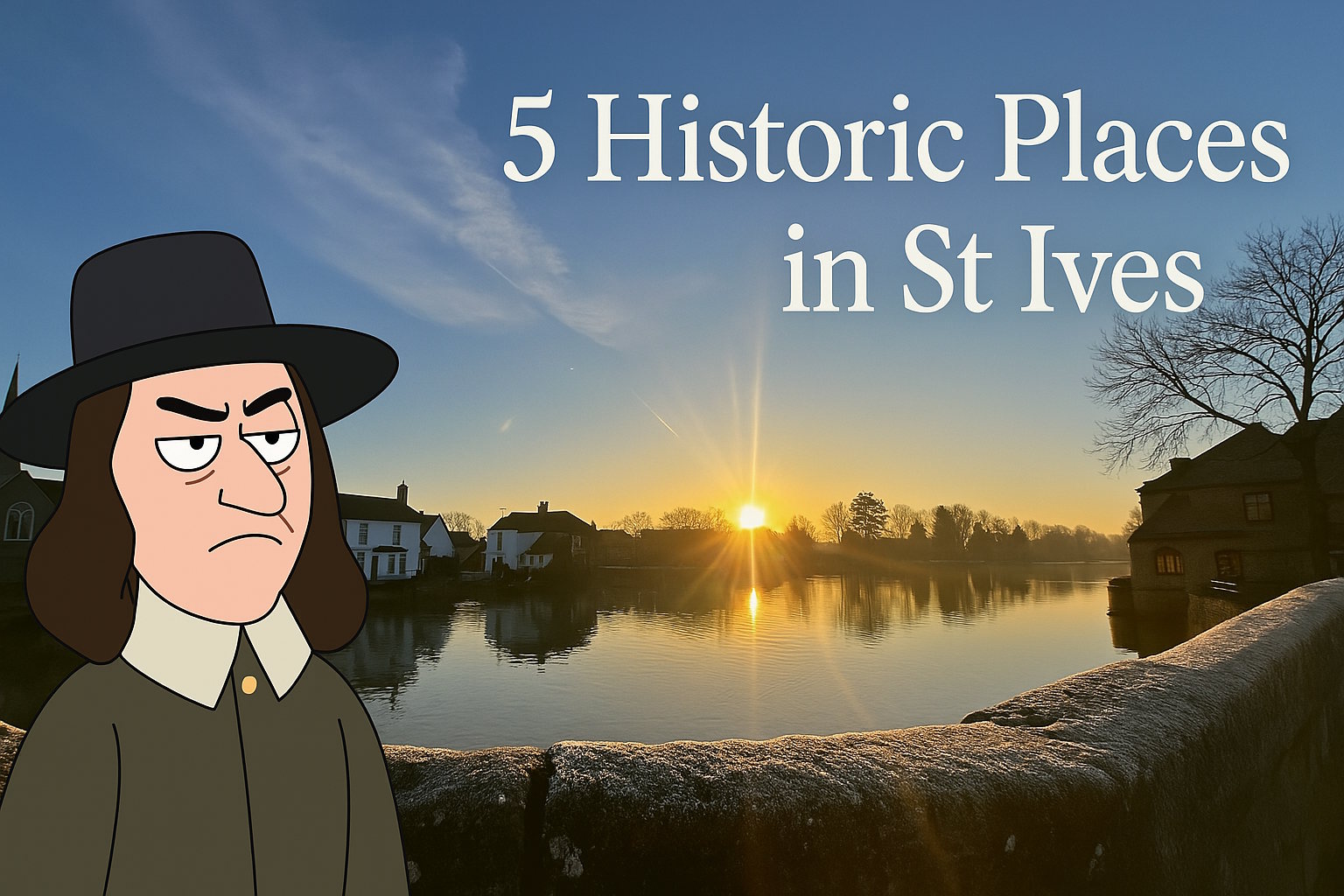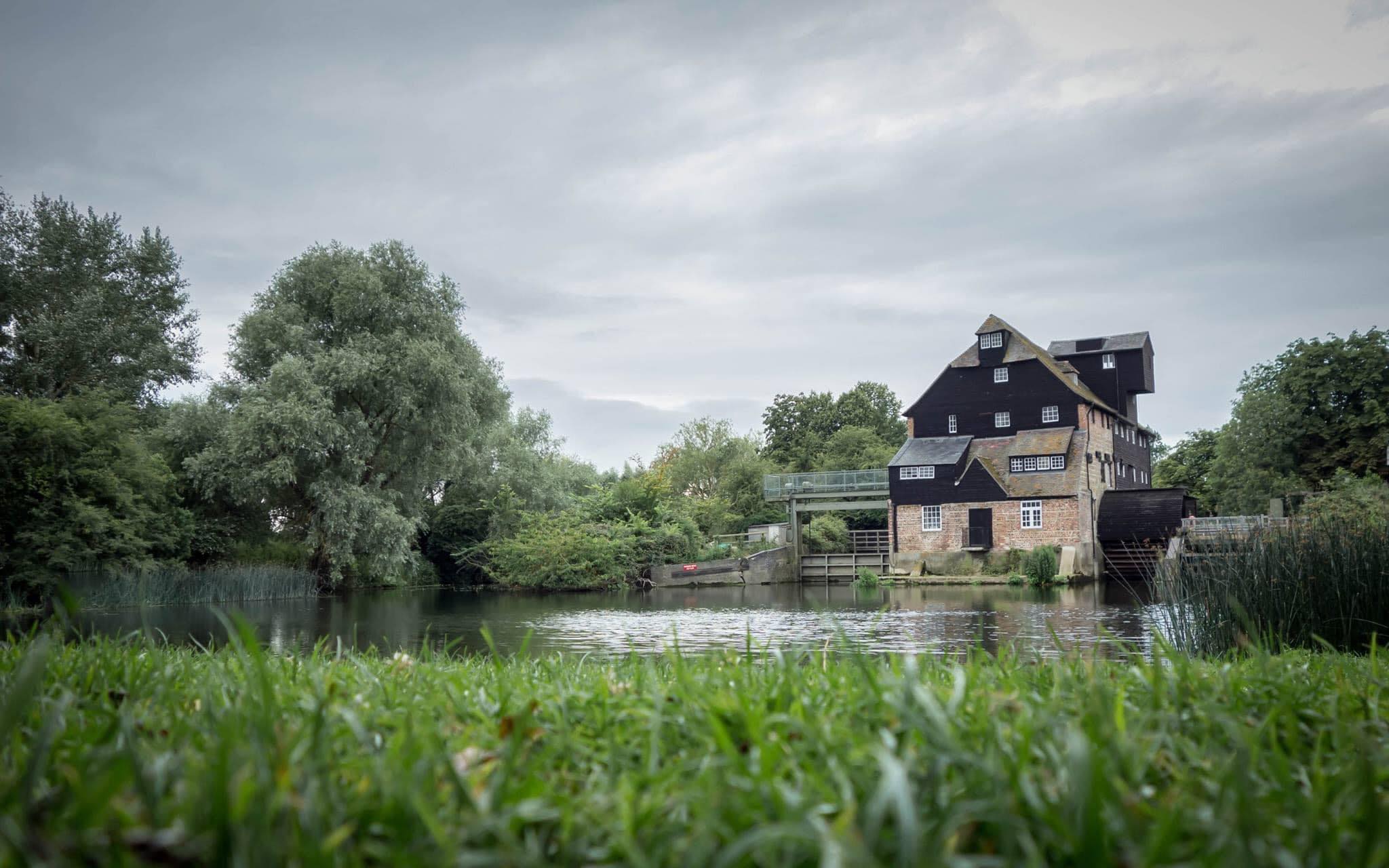St Ives Bridge is not just an ordinary crossing over the River Great Ouse. It’s practically a living relic.
Imagine if those walls could talk?
Can you imagine the people who have crossed St Ives bridge in days gone by?
Some believe the bridge dates back to 1107 AD when Ramsey Abbey first built a wooden bridge in the spot where the stone bridge now stands, but read on and we’ll show “photographic evidence” the bridge may be even older than that – dating back to prehistoric times!
Grab your explorer hat and let’s time travel through the bridge’s storied past. We will learn about when St Ives bridge was the “Gateway to the North”, and also what all this prehistoric nonsense is about!
An ancient crossing
Historians have dated St Ives Bridge back almost a thousand years.
Before locks and dams tamed the Great Ouse, the waters around St Ives were wide and shallow. Local residents will know how much the river floods in winter months, and this resembles what things were like way back when – more water, but much shallower.
The shallow water meant it was much easier to cross the river, but not as easy as our forefathers would have liked.
The first semblance of St Ives bridge dates back to 1107 AD when Ramsey Abbey built the first wooden bridge in the spot. This not only helped travelers, but provided the Abbey with an income through tolls.
Can you imagine monks collecting tolls from travelers, funding the abbey’s coffers?
This was very much the case back then, but can you imagine if St Ives residents had to pay a toll to cross the new bridge on Harrison Way?
The St Ives Bridge Dinosaur
Before you learn the history of the stone bridge and the chapel’s colourful past, lets take a step aside from the history books and discuss the prehistoric nature of St Ives bridge.
Did you know a dinosaur has lived on the bridge for many years?
With our modern busy lives and minds occupied by work schedules, Netflix, and social media instant gratification, we fail to miss the magic in the real world.
But I kid you not, there’s a dinosaur on St Ives bridge.
Have you seen him?
If you haven’t, I’ll introduce you. Meet Humphry, the Dinosaur of St Ives Bridge:

Yes, Humphry is merely an age old paint stain, but you have to admit he looks very much like a dinosaur?
Humphry has been there for years, continuously traversed by oblivious pedestrians, speedy cyclists, lorries, and rebel car drivers who choose to ignore the signs.
Next time you walk over the bridge, be sure to take a selfie with Humphry and post and tag us @The St Ives Post.
Right, are you ready to learn more about the history of St Ives Bridge?
The history of the St Ives stone bridge
By 1414, it was time for the original wooden bridge to receive an upgrade.
I expect the original wood was upcycled into fancy furniture and sold on the late middle age version of eBay, and a new stone bridge was erected in it’s place.
Just like modern times, the bridge wasn’t built over night. It wasn’t until 11 years later, in 1425, that the new St Ives was ready for action (and toll income).
And what a glorious bridge it was!
A year later, in 1426, the bridge was adorned with the real jewel in the crown – the chapel – a testament to the creativity of medieval architects.
Can you imagine such a structure getting planning permission today?
Imagine the paperwork, social media complaints, and lengthy investigations on the impact on climate?
As 21st Century St Ivians we must thank are ancestors, as St Ives Bridge is one of only four remaining medieval bridges with a chapel.
It’s easy to see why people come from far and wide to see the iconic landmark.
Oliver Cromwell’s explosive drama
You may notice how St Ives bridge isn’t symmetrical. On the northern (town) side the arches are pointy, and on the southern side they are round.
We can thank Oliver Cromwell for this oddity in architecture, as he blow up the south side of the bridge.
But why?
Historical records show Oliver Cromwell lived in St Ives between 1631 and 1636, but it was not until 1643 when he choose to blow up the bridge.
In 1643 England was amidst the English Civil War, and blowing up part of the bridge was a strategy designed to thwart the Royalists.
The bridge was eventually restored seventy years later, and you can still see the Gothic arches mingling with the more modern round ones.
A chapel for saints… and sinners
After the dissolution of the monasteries in 1539, the St Ives Bridge Chapel saw many transformations, including a stint as a dubious pub during the 1800s.
The name of the pub will spark your imagine – “Little Hell”.
For those of us who live in a local residence dating back to the 1800s, we can expect our original residents may have frequented the venue.
With pigs in the cellar and locals raising their glasses, you have to wonder, did any of them notice Humphry the Dinosaur lurking outside the door?
(Joke!)
Some say the chapel was used for a period as a brothel, but I feel unable to elaborate – I’ve never visited a brothel in my life.
The St Ives Bridge Chapel changed it’s use once again in 1930 when it was restored to its original form.
St Ives Bridge today, and what of “The Causeway”?
Since the construction of the Harrison Way bypass in 1980, St Ives Bridge is no longer the only southern access point into St Ives.
Thankfully, for the benefit of the town, the bridge is limited to foot traffic and restricted vehicle access. It remains a Grade I listed monument, fiercely protected by locals. Rumor has it they’re not just guarding history but the prehistoric imprint of Humphry the dinosaur as well.
And what about the causeway, built in 1822?
Considered by many as opportunistic parking for the town centre, the 55 arch bridge “The Causeway” is yet another of St Ives’ treasured relics.
Did you know it happens to be the largest road causeway in the UK?
Could there be more dinosaur stories hidden among its arches, whispering tales of times when dinosaurs roamed these lands?
Well yes, because on The Causeway you will find another paint stain resembling a dinosaur.
Can you find it?
Disclaimer: St Ives Post is a publication that blends news, commentary, and satire. While we strive to provide engaging and thought-provoking content, some of our articles may contain elements of satire, parody, or humour. These pieces are intended to entertain and should not always be taken as literal or factual reporting.
We encourage our readers to enjoy the content with a discerning eye and a sense of humour. If you’re uncertain whether an article is satirical or factual, it may be helpful to consider the context and tone. Please remember that our goal is to provoke thought and laughter, not to mislead.
By reading St Ives Post, you acknowledge and accept that some content is purely satirical in nature. Thank you for reading, and we hope you enjoy the wit and whimsy that St Ives Post brings to your day.
Please follow our Facebook Page.




